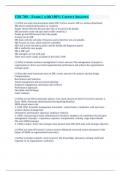CRI 700 – Exam || with 100% Correct Answers.
(1) What are some misconceptions about HR? correct answers HR is a useless department
HR doesn't understand business or creativity
People choose HR jobs because they like or are good with people.
HR processes create red tape and/or stifle creativity.3
People go into HR because they like people
Anyone can do HR
HR deals with the soft side of business and is therefore not accountable.
HR focuses on costs, which must be controlled
HR's job is to be the policy police and the health-and happiness patrol.
HR is staffed by nice people
HR is HR's job
HR managers are not well paid
There isn't much variety available in the field of HR
(1) What is human resources management? correct answers The management of people in
organizations to drive successful organizational performance and achieve the organization's
strategic goals
(1) Describe some functional areas of HR: correct answers Job analysis and job design
Compensations
Recruitment and Selection
Talent management and succession planning
Employee engagement, motivation and wellness
Performance appraisals
Discipline and discharge
Labor relations
(1) What are the HR evolutionary phases / how many phases are there? (4) correct answers 1.
Early 1900s: Personnel administration (hiring/firing/benefits)
HRM played minor role
2. 1930-1950: Scientific management movement - union liaison, compliance with new laws -
workers distrust management
Orientation, performance appraisal, employee relations
3. 1960s: outsourcing of many administrative functions, emphasis on contribution & proactive
management of people > expansion; expertise, compensation, training, wage improvement
The term HRM emerged
4. 1990s to today: Every line manager must possess basic HR skills help with strategic objective
(1) What are some HR metrics? correct answers Balanced scorecard system (measures of the
impact of HRM on organizational outcomes)
(1) What is Human Capital? correct answers The knowledge, education, training, skills and
expertise of an organization's workforce
,Human capital considered is as (or even more) important than financial capital: very costly for
company if employees are not working towards strategic goals
(1) What are the two types of environmental HRM influences? correct answers External:
economics conditions, labour market issues, technology, goverment, globalization,
environmental concerns
Internal: organization culture, organization climate, management practices
(1) Has HR become an increasingly strategic tool (changing perspective for essay)? correct
answers Perspectives on HRM have evolved considerably since the early 1900s (human
resources' evolutionary phases)
Instead of being simply an administrative role, HR now plays an important part of achieving
organization's strategic goals
With talent acquisition and retention a driving factor, organizations are focusing heavily on the
hiring/firing process and all the steps in between in order to have top talent that have the skills
necessary to meet and work towards the organization's strategic goals, while ensuring high
efficiency and employee morale
(1) What are the core HRM competencies?
HR competency model: nine functional areas correct answers Organizational
- Workforce planning and talent management
- Labour and employee relations
- Total rewards
Team based
- Professional practice
- Organizational effectiveness
- Labour and employee relations
Individual
- Learning and development
- Health, wellness, and safe workplace
- HR metrics, reporting, and financial management
Core HRM competencies
Credible activist: HRM must be credible and actually active in the change they propose
Culture and change steward: HR staff has a responsibility to shape and support a culture of
change as well as develop programs, strategies or projects to embed desired change throughout
the organization
Talent manager and organizational designer: HR specialists must embed theory, research and
practice into the processes, policies and structures of an organization to lower labour costs as
more employees shift around in the organization; helps to lower turnover, absenteeism and
occupational illnesses
, Strategy architect: integrating internal stakeholder and external stakeholder expectations to
contribute to strategy
Organizational executor: change agents who lead the organization and its employees through
organizational change, make the enterprise more responsive, flattening the pyramid
Business ally: play a role in environmental scanning for external opportunities and threats such
as: Changing technology, New rules, Succession planning, Identifying top talent, A new breed of
HR leaders
(2) What is Job Analysis? correct answers The procedure for determining the tasks, duties, and
responsibilities of each job, and the human attributes (interns of knowledge, skills, and abilities)
required to perform it
(2) What are the steps in Job Analysis? correct answers - Collect background information
- Select the representative positions and jobs to be analyzed
- Collect data
- Review the information collected with the incumbents and their supervisors
- Develop job descriptions and job specifications
- Communicate and review on an ongoing basis
(2) What is the information collected during Job Analysis used for? correct answers Allows to
write job descriptions and job specifications
Job analysis leads to: planning, recruitment, training etc.
(2) What is Job Design? correct answers The process of systematically organizing work into
tasks that are required to perform a specific job
(2) According to "A Few Words on Teamwork" what are the Five Stages of Group
Development? (Tuckman) correct answers Forming: groups created
Storming: group members get to know each other and see if personalities jive
Norming: group members settle into their roles
Performing: group begins performing tasks and objectives
Adjourning: group members close project and get reassigned to new projects/groups
(2) What is a job specification? correct answers A list of the "human requirements," that is, the
requisite knowledge, skills, and abilities needed to perform the job-another product of a job
analysis
(2) Define job enlargement / horizontal loading correct answers A technique to relieve boredom
that involves assigning workers additional tasks at the same level of responsibility to increase the
number of tasks they have to perform
(2) Define job enrichment / vertical loading (don't have to know the definition, just spot
examples): correct answers Any effort that makes an employee's job more rewarding or
satisfying by adding more meaningful tasks and duties




